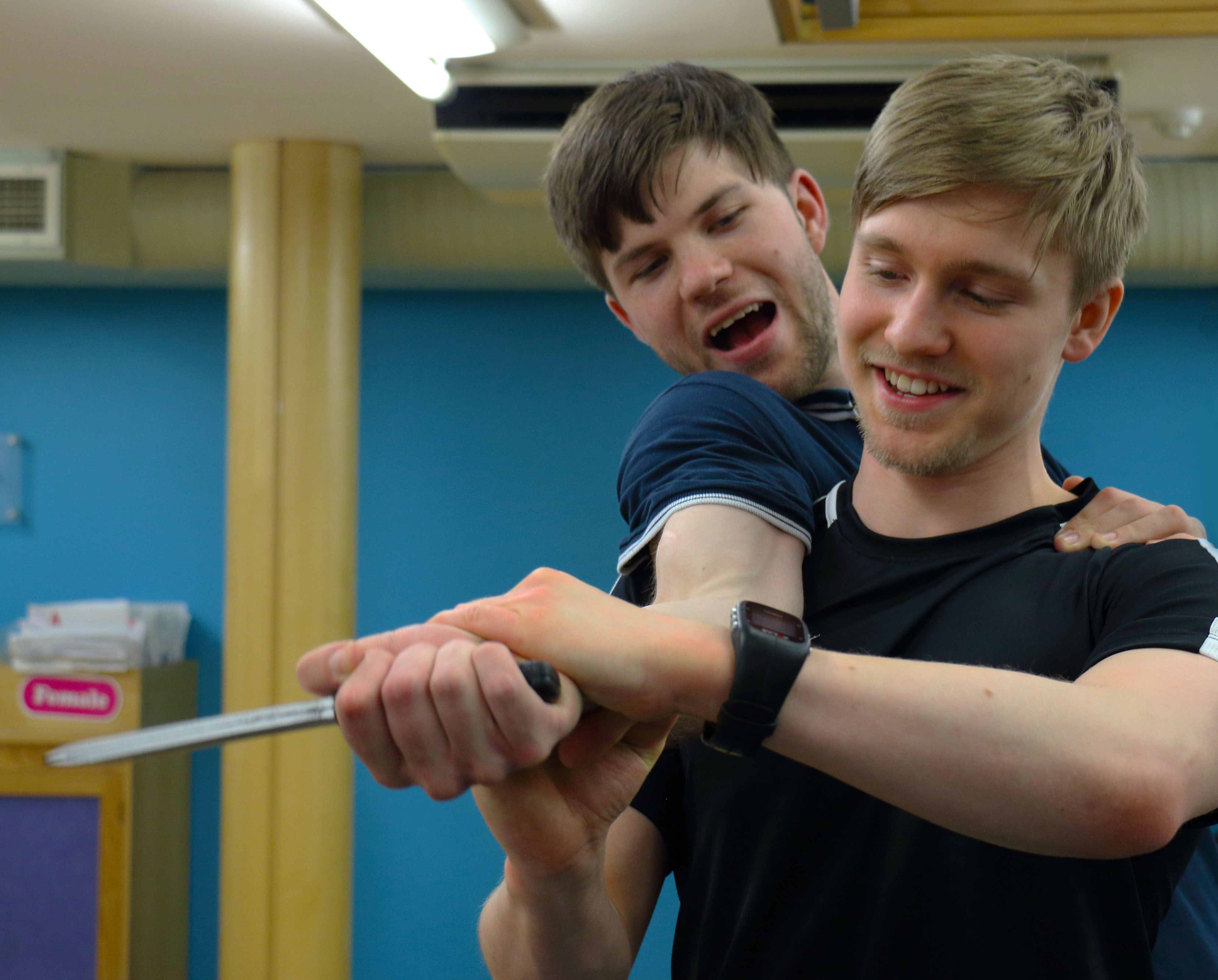Do Martial Arts Work on the Streets?
Today, I am discussing the relationship between martial arts and self defence. The aim of this is to inform you whether they are more of a Kung Do, or a Karatedo-not!
The Misconceptions
Martial Arts in general, are more than just fancy techniques that tie your opponents’ limbs in knots, and quite frankly, there is often an unrealistic representation that comes with them.
We are fed the lies of Hollywood. We let the likes of Jackie Chan show us that anyone who learns a martial art can battle against immeasurable odds. Realistically, how many people would it take to capture him in any of his films?
I can tell you now, it would not be many.
However, the media somehow has everyone’s expectations wrapped around their finger, portraying every martial artist as the next Bruce Lee.
Admit it, you hear that someone is a black belt, and you expect flying spinning kicks, instant takedowns, the whooshi finger hold, karate kid mind games, and possibly even have them go super saiyan if you get them angry enough (especially if you have shown your disappointment when they cannot do any of the previous).
Realistically, there is a relationship between martial arts and self-defence. Martial arts were mostly designed for protection after all. However, even the most experienced fighters can be outnumbered, taken from behind, or even killed.
Some train to suppress pain and harden themselves to withstand and deliver brutal blows, but they are still only human. We can certainly increase our probability of survival through training. At the end of the day though, if you are caught with a gun or knife, it is easy to see that despite training, we all bleed the same.
Now, I do not want to disregard martial arts or any defence systems as they are all incredibly useful. However, I want to highlight the fact that your initial beliefs may be misplaced.
The more you study and the more skilled you become, the higher your rate of survival in a situation. You will react quicker, be adaptable, observant, and technically precise, despite not having Spidey senses.
This still takes a lot of practice, though.
In a society filled with immediate gratification, people expect to be able to protect themselves having completed a single course, or even a single lesson. Yes, it may be better than nothing. However, it is safe to say that what these people had just learnt will be forgotten by the next day. Unfortunately, building your reactions takes time.
This is where martial arts come in. Hopefully, it will also explain as to why their practitioners are considered to have extraordinary abilities as well.
Martial artists have practiced their techniques frequently, and with plenty of criticism I’m sure. They have dedicated their mind and body to the art, reaping the benefits on their health and ability. (I may be selling it a little, but I am a biased Karateka.)
However, despite delivering skills to these individuals, not every martial art has street applications. Some disciplines are just too focused on their own techniques to be useful outside of the dojo.
“It would not work on the streets”, as self-proclaimed experts often say in comments of tutorial videos.
What Martial Arts are actually like?
As much as most martial arts are a marriage between sport, leisure, and self-defence, one of the three tends to wear the trousers, or in this case, the belt.
You can easily look at any style of combat and see where its reputation lies. Its reputation is usually associated with its specialism, and therefore its common practices.
Some examples:
-
Krav Maga:
It is often regarded as a self defence system, and is not a sport due to the brutality of it. Classes are also more intense than other martial arts due to the real world applications and training.
-
Boxing:
It is probably the most popular combat sport out there, and with it, people train like boxers for fitness, or to become a sportsman. But, who would turn up to a boxing gym for self-defence?
-
Karate:
Some martial arts are varied, especially the more traditional arts. Karate, for example, is fairly well-rounded. You have the Kata and Kumite sports, as well as self-defence elements. It is also practiced by those who attend leisurely due to a varied approach with regards to training. Now, some Dojos will tend to favour one of these elements more than the others. Most tend to practice all areas of the art, and/or dedicate specific sessions to each. However, whether this makes the self-defence elements practical or not is up for debate. Every instructor is different, and some will deviate from the art, whereas others are very strict on its constraints.
Ultimately, you probably know why you chose that one combat discipline out of so many others, so stick with it regardless. Unfortunately, there is not always much street defence in martial arts. This is especially when in the western world there are so many grading’s and competitions to keep us preoccupied. Practical self-defence can also deviate too much from the single style which the class is based on. This might not be a bad thing, but some people may have a problem with.
As much as learning to punch and kick in a line will help you to learn technique, it can only be adapted so much. However, what is there, is in fact great building blocks for self-defence.
The Benefits of Martial Arts
Through years of training in martial arts, you begin to understand the anatomy better; not just your own, but your opponents too. You understand how to manipulate someone’s body by shifting their weight, or placing pressure onto joints. You also learn how to use your art form within each of its elements. This makes you mentally flexible, and ideal for teaching new skills to i.e. street defence.
You would already be aware of how to use your body to deliver power. You would know how to move. You have experience, and therefore more absorbing when it comes to learning new techniques.
If you were to have only boxed, you would pick up direct attacks and evasion much quicker than a new starter. This then allows you to focus more of your time and effort on learning throws or weapon defences.
If you had experience in something that dabbled in a bit of everything (i.e. karate), then you would be able to just expand your knowledge. You would use what you already had. You would make your techniques stronger, or even adapt your new skills to you and your preferences.
Knowing a martial art means that when you do learn some street defence techniques, you may react in a slightly different way. There is no right or wrong way, as long as it is effective. However, your reactions will be based on your experience. For example, someone with experience in Judo or Jui Jitsu may throw someone over their hip if they get too close. On the other hand someone who practices MMA or Muay Thai would rather knee, or use elbow strikes.
By adapting it to what you are comfortable with, you will become more reactive. It will be easier to remember, and appear more natural to you. The last thing you want in a situation is to stand there thinking about what to do because it was what you were explicitly taught.
The Conclusion
On their own, martial arts may work on the street. It is not as likely if it is a strictly traditional one, or purely sports based. However, this training makes you highly adaptable for further skill consumption. Therefore, I recommend that every martial artist who is interested in personal protection takes additional lessons in street defence. This helps to adapt you to every situation, rather than being limited by the constraints of your art. You will also find that it helps to inject an element of realism, rather than being restricted to defending against any one attack from the list of your disciplines syllabus.
At the end of the day, no martial art was good enough for Bruce Lee, so he created his own. Develop your own style suited to your body and natural reactions. However, the key point to take away from this is not which is most effective or not, but instead, which is it that you are going to practice or expand on, and how frequently.
P.S. Follow me through any of my social media feeds to find out when I will be running my own self defence course: Empowerment.
Alternatively, I do offer a one to one service which covers the same content.
Watch my videos on Youtube – EmpoweringPT videos on Youtube.
Become Empowered Today! Call 0750 333 6773 or email James Edwards.

